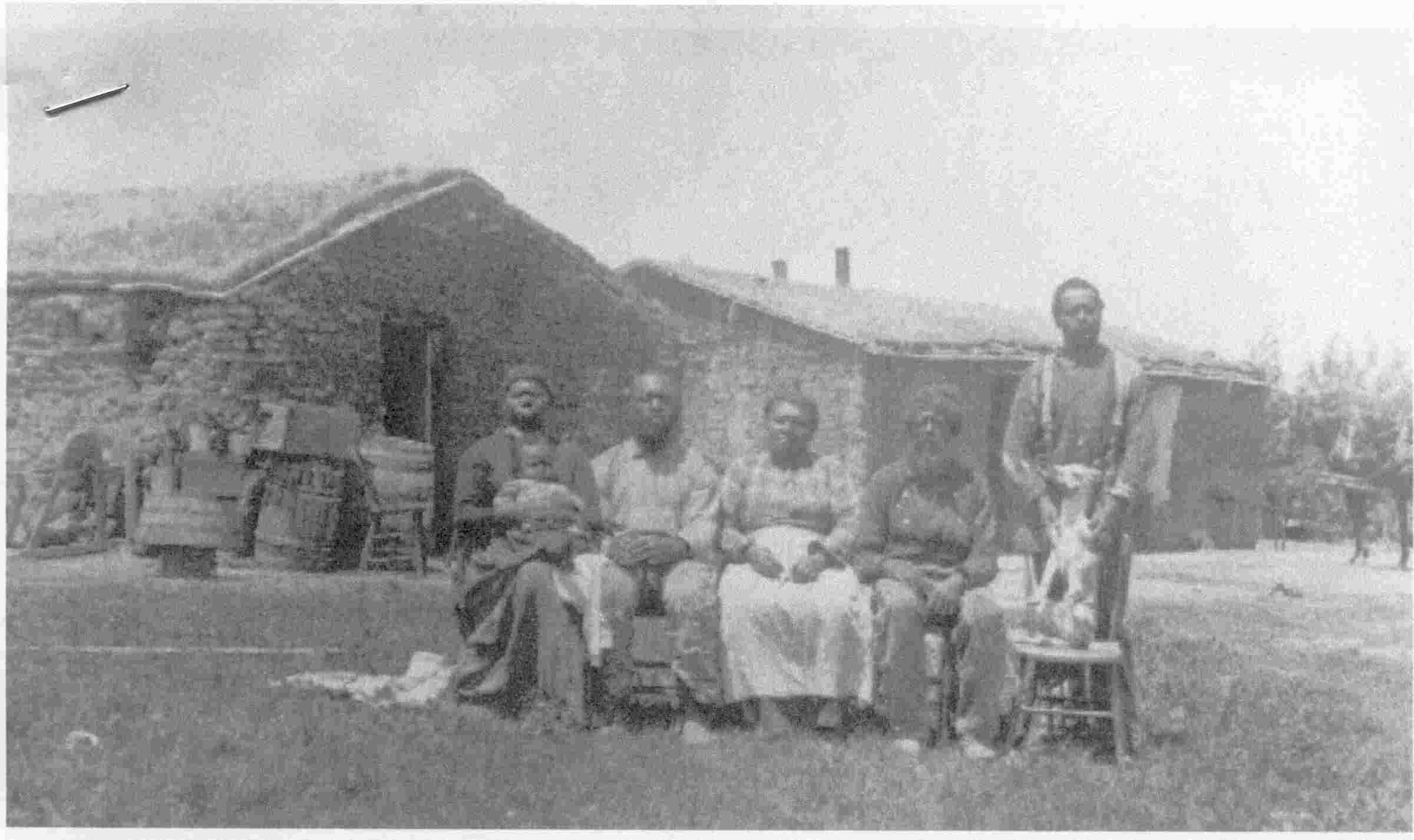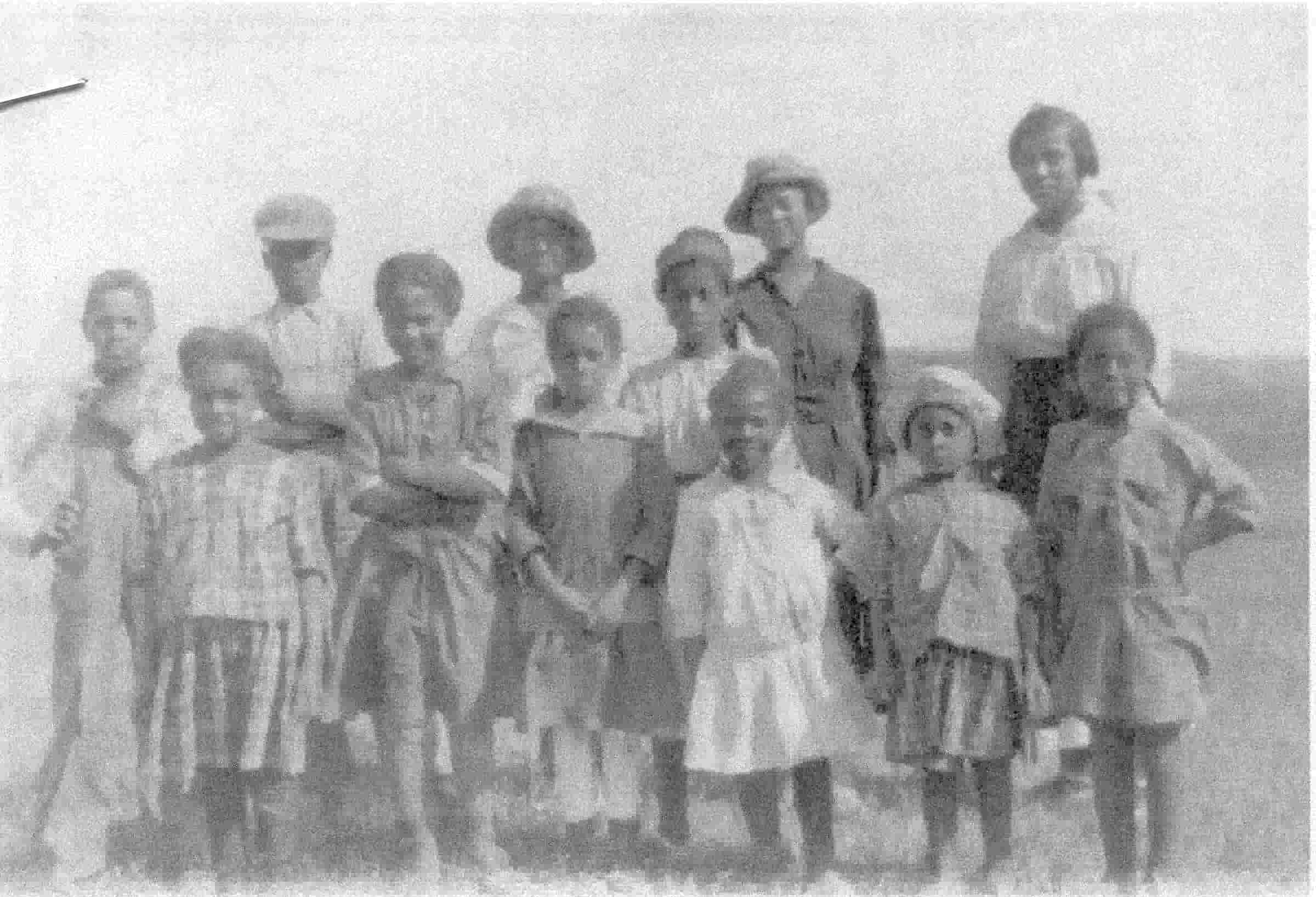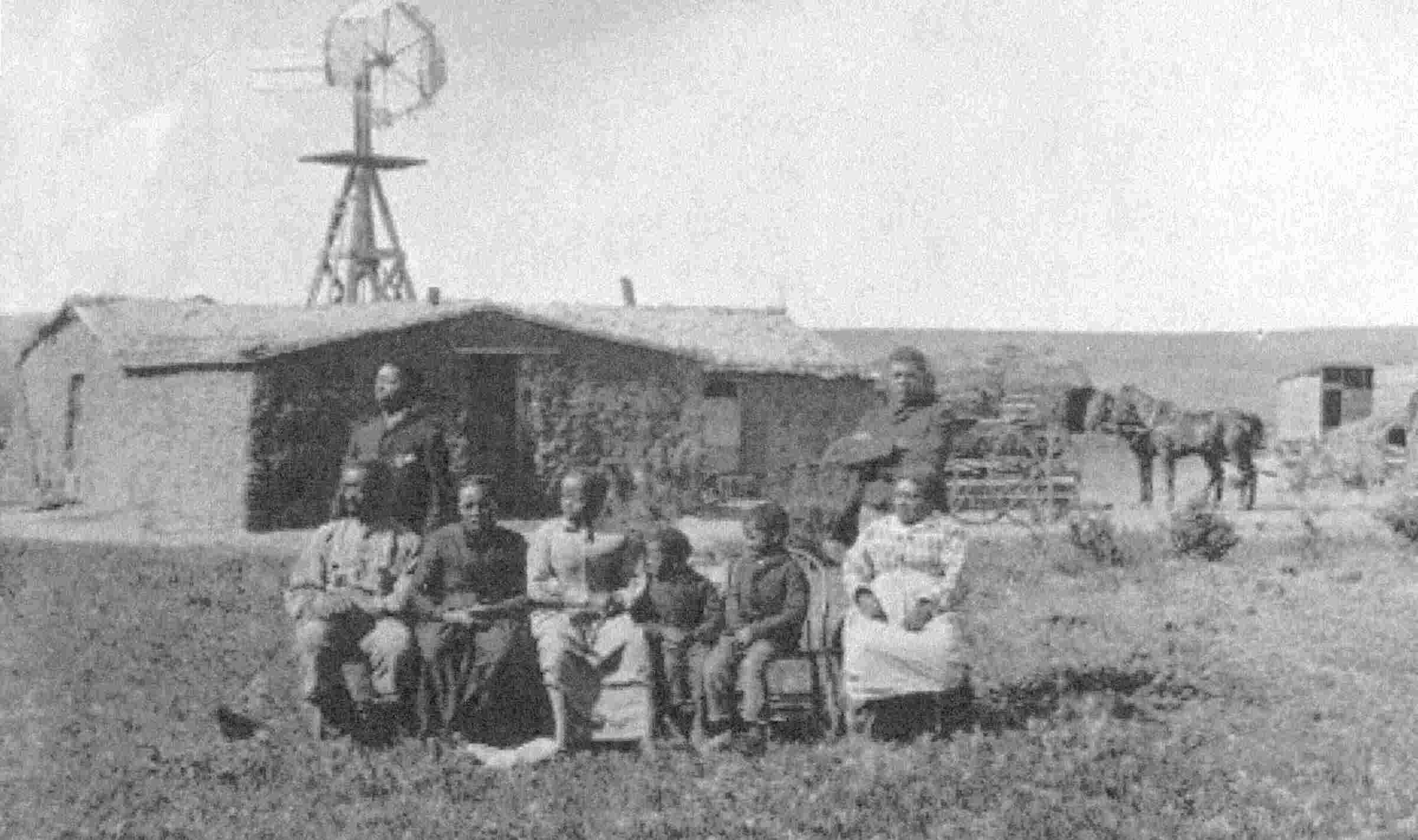Cherry County NEGenWeb
Project © 2000-2024

NEBRASKA'S AFRICAN AMERICAN HOMESTEADERS LOCATED AT DEWITTY
No unauthorized commercial use
may be made of this material
© 1969-2024 DJH
 Jeramiah Shores Family
Picture courtesy of Nebraska State Historical Society
Jeramiah Shores Family
Picture courtesy of Nebraska State Historical Society
Although he was never one of its residents, a railroader named Clem Deaver
sparked settlement of the largest and most permanent colony of Negro
homesteaders in Nebraska. Also, oldtimers in the Sand Hills credit him
with being the first Negro to file for land under the Kinkaid Act in
Cherry County.
Shortly after the act went into effect in June 1904, Deaver journeyed
from the booming railroad town of Seneca in Thomas County to file for his
Kinkaid at the land office located in adjoining Cherry County at Valentine.
At this time Deaver learned that some 50,000 acres of unclaimed land were
available 10 miles northwest of Brownlee. This tract bordered the wandering
North Loup River and its environs for some 15 miles in the eastern part of
Cherry County.
The railroader returned to Seneca and relayed the information to others of his
people living in Nebraska. Initial settlement of this land was made in the
spring of 1907. Soon, sod houses dotted the area to become the DeWitty settlement
in Cherry County. After his initial efforts, Deaver dropped from sight and his
final fate is unknown.
Prior to the DeWitty attempt, several groups of Negroes had tried to establish
such settlements. These attempts were made after the Civil War when the great
exodus to the North was taking place. The first settlers were Negroes who lived
temporarily in Omaha and migrated to Franklin County in 1871 to take lands under the
Homestead Act of 1862. They had hopes that other settlers would join them so they
laid plans for a town they named Grant to be situated on a nearby stream dubbed
Lovely Creek. Sites for a brickyard and a courthouse were marked by ash poles tied
with strips of hide. Grand never materialized, for lack of money bested the
homesteaders before the year was out and they returned to Omaha.
In 1880, the first of two groups of Negroes came from Tennessee. These people
leased land near Aurora in Hamilton County. The second contingent settled in
Harlan County in 1889. Both of these ventures failed as the southerners could not
stand the bitter bite of Nebraska winters or cope with the hardships they
encountered. Consequently, all of them returned to Tennessee. However, by the
turn of the century, one colony of Negroes was succeeding. These people filed
claims on land near Overton in Dawson County in 1880. The homesteaders forming
the nucleus of this settlement came from Canada. They were educated, weather
oriented, and conditioned. Some were skilled artisans, and all brought goods,
supplies and money to sustain them until they could harvest a crop.
When Deaver's news reached this settlement, none of these homesteaders were
then inclined to sell their lands and move to Cherry County to obtain larger
tracts for their farming operations. However, the 2 year drought that started
in 1905 eventually caused them to change their minds. Charles M. Meehan, who
had spearheaded the move of the initial Negro settlers from Canada, was
responsible for the exodus from Dawson County. Before a haphazard migration was
started, Meehan suggested that one of his sons, Dennis, go to Cherry County and
see if these lands were still available. His neighbors agreed, and when the
young man returned and confirmed Deaver's report, Meehan was ready to pioneer
the move.
A short time later, a train of three wagons journeyed to the lands bordering the
North Loup. Meehan rode in the wagon driven by his daughter Rosetta. Dennis had
George Brown as his passenger while William Crawford rode alone. Crawford and
Brown, Meehan's brother-in-law, had come with him from Canada. These three would
be the first to file Kinkaids in the DeWitty settlement.
After filing their claims, the men were soon busy building sod houses to
accommodate their families who would come with the other members of the
Overton colony. By the fall of 1907, DeWitty had a population of 66, for although
only 7 Kinkiads were filed by claimants, all of them had large families. By 1917,
the settlement had 100 families.
Two manuscripts written in 1964 by Ava Speese Davis of St.Paul, Minnesota, one of
Charles Meehan's granddaughters, tell much about the DeWitty settlement and its
people. Until these memoirs were received by the Nebraska State Historical Society
it was little known outside of Cherry County that Meehan, responsible for the
establishment of both the Overton and the DeWitty settlements, was Irish.
Previously published reports stated that the Canadian settlers were all southernts
of southeran slaves who had escaped from bondage via the famed underground railway.
Meehan was born in Detroit shortly after his parents migrated from Ireland in 1885.
A few years later the Meehan's moved to North Buxton near Windsor, Ontario. Here,
white Charles Meehan went to school with and had as his boyhood companions, George
and Maurice Brown, whose father was a Negro and whose mother was an Indian. The Brown's
had adopted a little Negro girl, Hester Freeman, whose parents had died. The Irishman
fell in love with her and they weremarried quite some time prior to the move to
Nebraska. It was Meehan who learned of the United States land available under t he
Homestead Act. He persuaded the Brown brothers and William Crawford to bring their
families from Canada to their first settlement in Nebraska.
Meehan loved and respected these people. According to his granddaughter, Mrs Davis,
color made no difference to him. People were people , men were men, and women, ladies,
unless proved otherwise. This Irishman did much to help his friend susurmounthe
difficulties they encountered while homesteading in Dawson CoCountyHe shared his
knowledge of farming with otothersike William Walker and Albert Riley, who came to
settle later, and this helped them immeasurably. Meehan's sense of humor tinged with
a touch of blarney and his goodwill to all newcomers helped make them feel more secure and
confident of success in their new venture. When Meehan counseled the move to Cherry
County, it was only natural that his fellow settlers would follow him.
Thanksgiving Day 1907 was memorable for the Irishman and his wife. Their two oldest
children Rosetta and Dennis, were mamarriedn a double wedding ceremony at Westerville
in Custer County. Dennis married Ida Shores while Rosetta married Charles Speese.
Dennis Meehan brought his bride to live in a Kinkaid near his father's. He served as the
first schoolteacher in the DeWitty settlement as well as its last postmaster. During
the years following, Meehan was able to provide an adequate income for his large family by
combining farming and ranching.
Rosetta and her husband stayed in Custer County for a year before taking a homestead
claim near Torrington, Wyoming. Two crops in nine years proved discouraging, so they
returned to Cherry County in 1916 where they lived a life quite similar to that of their
DeWitty neighbors.
Mrs. Davis, the daughter of Rosetta and Charles Speese, states her father rented hay and
cropland all the time they lived in DeWitty. Corn, potatoes and beans were "staple crops
afield". Speese cattle were wintered some 20 miles northeast of their homestead near
Wood Lake and shipped to Omaha via the railroad at Seneca. They bred mules from 70 brood
mares and a reregisteredonkey named Pittman-Napolean.
After the Speese's returned to Cherry County, lumber was scarce, so the first settlers
came up with a system of obtaining wood for roofs and floors. Sod houses, owned by the
Kinkiders who found farming not to their taste would be sold to newcomers for the buyer
to hitch a fourhorsee team to the roof, apply a whip to their rumps and bring walls
and roof collapsing on the floor. Roof and floor would be lashed together, the team hitched
to the package, and the buyer would take part of his new home to his claim.
The community church was established in 1910 by Reverend O.J.Burchkardt, a missionary
of the AfricanEpiscopall Church of Lincoln. People of all faithsworshippedd here in harmony
throughout the 29 year life of the settlement.
 L-R Howard Spasey,Lena Speese, Herbert, Mildred Meehan,
Ellen Ford, Anna Ford, ? Ford, Estyr Ford, Flora Speese, The Teacher-Fern
Walker Haynes, Marie Meehan.
L-R Howard Spasey,Lena Speese, Herbert, Mildred Meehan,
Ellen Ford, Anna Ford, ? Ford, Estyr Ford, Flora Speese, The Teacher-Fern
Walker Haynes, Marie Meehan.
Picture courtesy of Nebrakska State Historical Society
William Walker's daughters, Goldin and Fern, taught in two of the three schools located in
the district. Goldie Walker Haynes took great pride in her school. The floor was carpeted,
white curtains hung at the windows, and she always tried to obtain the best equipment for her
students.
People lived pretty much by the golden rule, and crime waspracticallyy nonexistent.
Only one case of rustling is recalled by Mrs. Davis. Onenightt a man made off with her
father's favorite horse, Rex. The next morning, Charles Speese followed Rex's hoofprints,
found his horse, and brought him home without incident.
Like many of their neighbors, Speese and his wife felt their children's education should be
further supplemented by a home reading program. The State Library at Lincoln sent
books to rural families, so Rosetta requested them. Her children read them from cover to
cover. Material ranged from thEncyclopediaia Britannica to autobiographies to theclassicsa
to poetry, especially that of Paul Lawrence Dunbar. Dunbar's works, however, confused
the young Speese's, for the southern Negro poet wrote in the vernacular of his people.
According to Mrs. Davis, "Nobody that we had ever known talked like that, so Dad had to
explain the poems to us".
Droughts and hard times did not defeat most of these original Kinkaiders. Many of them
like William Ford made out by working for white ranchers in the area. Ford reportedly
walked 1milesls a day from his 0home to the Lee Ranch and back again, arriving before
seven in the morning and leaving after dark. Robert Hannahs opened a barbershop in Brownlee
and built up a fine trade in the community. He would barber for his neighbors in his home
during the evenings.
Traditionally on the first Sunday of August the entire settlement would gather at the
Robert Hannah's for a picnic. The entire DeWitty community would turn out, too, for the
Fourth of July celebrations put on by the Danish residents of Brownlee. Brownlee staged
a rodeo at this time and DeWitty cowboys offered stiff competition to participants from
as far away as Thedford. The Negroes added excitement to the footraces, too, especially
when William Meehan entered. William would run tfirstirt part of the race in the
conventional manner, turn at the halfway mark, and run backwards to finish the race.
According to his neice, he won every contest he entered.
Several of the DeWitty men were good musicians and played for dances in the area. To learn
new tunes, the group would gather at the A.P.Curtis home to listen to tphonographaph. Soon,
they were abel to play the tune they heard. One was such a good musician that he
could go to sleep while playing for an dance and still never miss a note.
DeWitty's baseball team, the Sluggers, played teams from Thedford and Brownlee and always
drew a crowd. Besides being fine players, members were natural clowns. The Slugger's antics
were similar to those of the Harlem Globetrotters of basketball renown.
Droughts and crop failures following World War 1 caused DeWitty's demise. Some families mortgaged
their properties, than lost them. Others like Albert Riley, the last resident to leave DeWitty in
1936, sold their lands to neighboring white ranchers.
Today, the sod buildings have all disappeared. The cemetery is now part of land owned
by Don Hanna, a former white neighbor of the Speeses. In spite of the heartbreaks and
frustrations suffered by the DeWittians, their children remember the good times they shared.
Descendantsants of the original settlers scattered from coast to coast. Most likely, if
if some of them should return to the area as Mrs. Mrs. Davis did in 1960, they would
paraphrase the sentiments she expressed after her visit with Don Hanna at his ranch. She
wrote glowingly of the happy memories the Sand Hills held for her. People were neighbors
in the fullest sense of the word, and segregation was and still is unknown just as it was
when Charles Meehan brought his family to the place called DeWitty so long ago.

L-R Standing:sons Henry & Radford, Seated:Moses Speese, wife Susan Kirk Speese, daughter Sarah,
sons Charles and Earl.
Picture courtesy of Nebraska State Historical Society
Copyright 1969, NEBRASKALAND Magazine. Story written by Jean Williams. Posted with permission.




